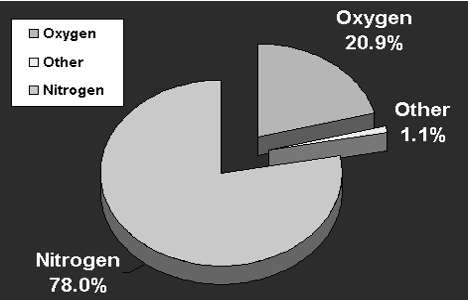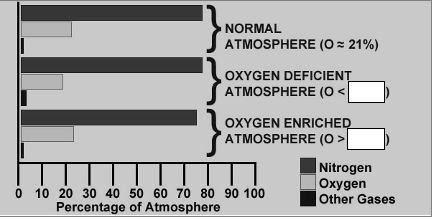2 Confined Space Hazards
Confined Space Hazards
Three main categories of hazards are encountered in confined spaces:
- Atmospheric
- Physical
- Biological
Atmospheric Hazards
A hazardous atmosphere means an atmosphere that may expose employees to the risk of death, incapacitation, impairment of ability to self-rescue (escape unaided from a confined space), injury, or illness from one or more of the following causes:
- Oxygen Deficiency
- Oxygen Enrichment
- Toxic Gases & Vapours
- Flammable Gases & Vapours
You must test the air in a confined space to determine if a hazardous atmosphere exists.
Unknown atmospheric conditions shall be deemed immediately dangerous to life or health (IDLH) until an assessment conducted by a competent person has proved otherwise.
Atmospheric conditions in a confined space can change very quickly.
Oxygen Deficiency & Enrichment


| Oxygen levels between 18% and 12% | Increased Breathing |
|---|---|
| Impaired Attention | |
| Oxygen levels between 14% and 10% | Faulty Judgement |
| Heart Damage | |
| Oxygen levels between 10% and 6% | Nausea |
| Loss of Movement | |
| Oxygen levels below 6% | DEATH within minutes |
Exercises
- Why might oxygen deficiency be considered the most dangerous atmospheric hazard?
- Discuss and list the causes of oxygen deficiency.
- Why is an oxygen enriched atmosphere so hazardous?
Toxic Gases & Vapours
Contaminants in the air can result in an atmosphere that is toxic, or poisonous to workers. This may cause illness, injury or death.
Many of these contaminants are in the form of gases and vapours. In the past, miners and cargo ship crews would use canaries and chickens to gauge whether the atmosphere in a space was safe to breath. Canaries, for example, react quickly to carbon monoxide, a deadly gas. If the canaries breathed a small amount of the gas, they would sway on their perches before falling. This gave miners warning that the deadly gas was present.
Today, we generally use electronic monitors to determine when there are toxic gases and vapours in the atmosphere. The concentration of the substance inside the confined space must be determined using a recently calibrated and functionally-tested monitor with the correct sensor. Such a monitor should sound an alarm that will alert workers when the allowable limit is reached.
The American Conference of Governmental Industrial Hygienists (ACGIH) has established Threshold Limit Values (TLVs) for most common airborne toxic substances. TLVs are the legal limits of exposure in NS and federal jurisdictions.
- TLV – TWA (Time Weighted Average)
- TLV – STEL (Short Term Exposure Limit)
- TLV – Ceiling
In most cases, contaminant levels (and TLVs) are expressed in parts per million (ppm).
1 ppm =
- 1 inch in ___ miles
- 1 minute in ___ years
Hydrogen sulfide (H2S)
- Commonly found in sewers
- Also known as “sewer gas” (smells like rotten eggs)
- Odor threshold: 0.02 – 0.2 ppm
- Colorless, flammable gas.
- Strong odor BUT fatigues your senses.
- Deadly! Affects nervous system.
- Heavier than air
- 8-Hour TWA TLV = 1 PPM; STEL = 5 PPM
Carbon monoxide (CO)
- Colorless, odorless gas
- Slightly lighter than air
- Chemical asphyxiate. Deadly!
- Primary source: incomplete combustion
- Signs/Symptoms: Headache. Confusion. Dizziness. Nausea. Unconsciousness. Death.
- 8-Hour TWA TLV = 25 PPM
Other Toxic Chemicals
Other toxic chemicals can include vapors from liquid residues in storage tanks, or chemical products used in the confined spaces. Gases and vapours from these chemicals can quickly reach toxic levels in the air of a confined space, especially when products are being sprayed or brushed onto surfaces.
Fatality!
A worker became ill and was hospitalized after using an epoxy coating that contained a chemical containing black tar (2-nitropropane and coal tar pitch) to coat a valve on an underground waterline. The valve was located in an enclosed service vault.
The worker was released from hospital the next day, but was re-admitted four days after the incident and died six days later from liver failure.
Exercise
Discuss and list the toxic gases and vapours that may be present in your confined spaces:
Flammable Gases & Vapours
Always be aware of the fire triangle when working in confined spaces!
Containers of fuels such as gasoline and propane should not be taken into a confined space, as fuel can easily vapourize, then burn or explode. Some other common substances that can cause explosions or fires in confined spaces:
- Acetylene gas from leaking welding equipment
- Methane gas and hydrogen sulfide gas produced by rotting organic wastes in sewers or tanks
- Hydrogen gas produced by contact between aluminum or galvanized metals and corrosive liquids
- Solvents such as acetone, ethanol, toluene, turpentine, and xylene, which may have been introduced into the space through spills or by improper use or disposal
A trained person must test the atmosphere for flammable gases and vapours before entering.
Lower explosive limit (LEL) is the lowest concentration where a material is flammable in the air. Upper explosive limit (UEL) is the highest concentration where a material is flammable in the air.
| MATERIAL | LEL | UEL |
|---|---|---|
| GASOLINE | 1.4% | 7.4% |
| TOLUENE | 1.2% | 7.1% |
| ACETYLENE | 2.5% | 100% |
| METHYL ALCOHOL | 6.7% | 36% |
| METHANE | 5% | 15% |
Important Note
For virtually all confined space work, the limit for entry is 10% of the LEL. Refer to regulations for details.
When flammable gases and vapours may be present in confined spaces, sources of ignition must be very strictly controlled. Common sources of ignition include:
- Welding
- Cutting
- Soldering
- Grinding
- Energized electrical equipment
- Static electricity
Exercise
Discuss and list the flammables that may be present in your confined spaces, and may cause an explosive atmosphere:
Physical Hazards
A thorough hazard identification/risk assessment is necessary to properly identify the several physical hazards that may be encountered in confined space work.
Some examples of physical hazards are provided in this section
Loose & Unstable Material
Unstable solids such as sand, sawdust or grain can be very hazardous in tanks, bins, hoppers and other confined spaces. These granular materials, particularly if moist, can form bridges. If jarred, these can collapse onto or beneath workers, engulfing them.
Bins and hoppers in which materials are conveyed or augered into the bin are particularly dangerous. A worker may be trapped or crushed when material is discharged.
Slip, Trip & Fall Hazards
Many confined spaces have hatchways, ladders and obstructions, which increase the risk of falling. In addition, the floors of tanks, vaults, and other spaces are often wet and very slippery.
Falling Objects
Being struck by falling objects is often a hazard in confined spaces, especially if access covers or other work areas are located above workers.
Mechanical & Electrical Hazards
Mechanical hazards commonly encountered in confined spaces include: augers, pump impellors and agitators. Residual energy, such as gravity or accumulated pressure, may also pose a risk. Even when the power is disconnected and locked-out, unsecured equipment can suddenly move, striking or crushing a worker.
Electrical shock can result from defective extension cords and cables, or contact with other electrical conductors or components. Wet conditions heighten the risk.
Fluids In or Entering the Space
Confined spaces must be checked for water and other fluids that could drown or injure workers. Piping systems that may introduce fluids must be identified and properly secured. If valves are used to isolate piping systems, double block and bleed arrangements may be required.
Temperature Extremes
Special precautions must be taken when workers enter confined spaces where temperature extremes are likely to be found. These include boilers, process vessels, steam pits and freezer tunnels. Heat stress and cold stress are serious hazards that can result in fatality.
Exercise
Discuss and list the physical hazards that may be present in your confined spaces:
Biological Hazards
Illness, injury and death can result from exposure to biological hazards. Confined space hazard identification/risk assessment must consider the presence of:
- Viruses
- Bacteria
- Fungi & Mould
- Toxins
- Animals
Exercise
Discuss and list the biological hazards that may be present in your confined spaces:
